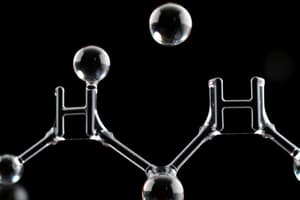Podcast
Questions and Answers
Alcohols are organic compounds where a hydroxyl group replaces the ______ atom of an aliphatic carbon.
Alcohols are organic compounds where a hydroxyl group replaces the ______ atom of an aliphatic carbon.
hydrogen
An alcohol molecule consists of two parts: the alkyl group and the ______ group.
An alcohol molecule consists of two parts: the alkyl group and the ______ group.
hydroxyl
Like water, alcohols are polar containing an unsymmetrical distribution of charge between the oxygen and ______ atoms.
Like water, alcohols are polar containing an unsymmetrical distribution of charge between the oxygen and ______ atoms.
hydrogen
Types of Alcohol: Monohydric alcohols contain ______ -OH group.
Types of Alcohol: Monohydric alcohols contain ______ -OH group.
Based on the number of carbon atoms attached to the carbon bonded to the -OH group, alcohols are classified into three types: Primary alcohol has ______ carbon atom attached.
Based on the number of carbon atoms attached to the carbon bonded to the -OH group, alcohols are classified into three types: Primary alcohol has ______ carbon atom attached.
Glycerol is an example of a ______ alcohol.
Glycerol is an example of a ______ alcohol.
The presence of hydroxyl group is the main factor in determining the ______ of alcohol.
The presence of hydroxyl group is the main factor in determining the ______ of alcohol.
Alcohols are more water-soluble than simple hydrocarbons due to the presence of the polar ______.
Alcohols are more water-soluble than simple hydrocarbons due to the presence of the polar ______.
Alcohols are able to form hydrogen bonds, resulting in higher ______ points compared to hydrocarbons.
Alcohols are able to form hydrogen bonds, resulting in higher ______ points compared to hydrocarbons.
The boiling point of alcohols decreases with an increase in ______ in aliphatic carbon chains.
The boiling point of alcohols decreases with an increase in ______ in aliphatic carbon chains.
Alcohols dissolve in water due to the presence of ______ bonds.
Alcohols dissolve in water due to the presence of ______ bonds.
Alcohols have many uses in our everyday world. They are found in beverages, antifreeze, antiseptics, and ______.
Alcohols have many uses in our everyday world. They are found in beverages, antifreeze, antiseptics, and ______.
Ethanol is most prominent in nature as it is the product of ______.
Ethanol is most prominent in nature as it is the product of ______.
Chemical Properties of Alcohol: Lucas test is used to distinguish between alcohols according to the rate of reaction. Tertiary alcohol reacts directly with Lucas reagent. The reactivity order is 30 > 20 > 10 > ______.
Chemical Properties of Alcohol: Lucas test is used to distinguish between alcohols according to the rate of reaction. Tertiary alcohol reacts directly with Lucas reagent. The reactivity order is 30 > 20 > 10 > ______.
Oxidation by cold KMnO4: Primary alcohol oxidizes to form ______.
Oxidation by cold KMnO4: Primary alcohol oxidizes to form ______.
Formation of Halides: Halogens such as chlorine or bromine replace the -OH group in an alcohol. ROH + HCl → R-Cl + ______
Formation of Halides: Halogens such as chlorine or bromine replace the -OH group in an alcohol. ROH + HCl → R-Cl + ______
Reaction with HNO3: The reaction of some alcohols with nitric acid, HNO3, gives ______ esters.
Reaction with HNO3: The reaction of some alcohols with nitric acid, HNO3, gives ______ esters.
Dehydration of Alcohol: The dehydration reaction of alcohols to generate alkene proceeds by heating the alcohols in the presence of a strong acid, such as sulfuric or phosphoric acid, at high ______.
Dehydration of Alcohol: The dehydration reaction of alcohols to generate alkene proceeds by heating the alcohols in the presence of a strong acid, such as sulfuric or phosphoric acid, at high ______.
Flashcards are hidden until you start studying
Study Notes
Alcohols: Definition and Structure
- Alcohols are organic compounds where a hydroxyl group replaces the hydrogen atom of an aliphatic carbon.
- An alcohol molecule consists of two parts: the alkyl group and the hydroxyl group.
Physical Properties of Alcohols
- Alcohols are polar, containing an unsymmetrical distribution of charge between the oxygen and hydrogen atoms.
- Alcohols are more water-soluble than simple hydrocarbons due to the presence of the polar hydroxyl group.
- Alcohols are able to form hydrogen bonds, resulting in higher boiling points compared to hydrocarbons.
- The boiling point of alcohols decreases with an increase in branching in aliphatic carbon chains.
- Alcohols dissolve in water due to the presence of hydrogen bonds.
Types of Alcohols
- Monohydric alcohols contain one -OH group.
- Alcohols are classified into three types based on the number of carbon atoms attached to the carbon bonded to the -OH group: primary, secondary, and tertiary.
- Primary alcohol has one carbon atom attached.
- Glycerol is an example of a polyhydric alcohol.
Chemical Properties of Alcohols
- The presence of hydroxyl group is the main factor in determining the solubility of alcohol.
- Lucas test is used to distinguish between alcohols according to the rate of reaction.
- The reactivity order is tertiary > secondary > primary > methyl.
- Primary alcohol oxidizes to form aldehyde or acid by oxidation with cold KMnO4.
- Formation of Halides: Halogens such as chlorine or bromine replace the -OH group in an alcohol, producing alkyl halides.
- Reaction with HNO3: The reaction of some alcohols with nitric acid, HNO3, gives nitrate esters.
- Dehydration of Alcohol: The dehydration reaction of alcohols to generate alkene proceeds by heating the alcohols in the presence of a strong acid, such as sulfuric or phosphoric acid, at high temperatures.
Uses of Alcohols
- Alcohols are found in beverages, antifreeze, antiseptics, and pharmaceuticals.
- Ethanol is most prominent in nature as it is the product of fermentation.
Studying That Suits You
Use AI to generate personalized quizzes and flashcards to suit your learning preferences.




